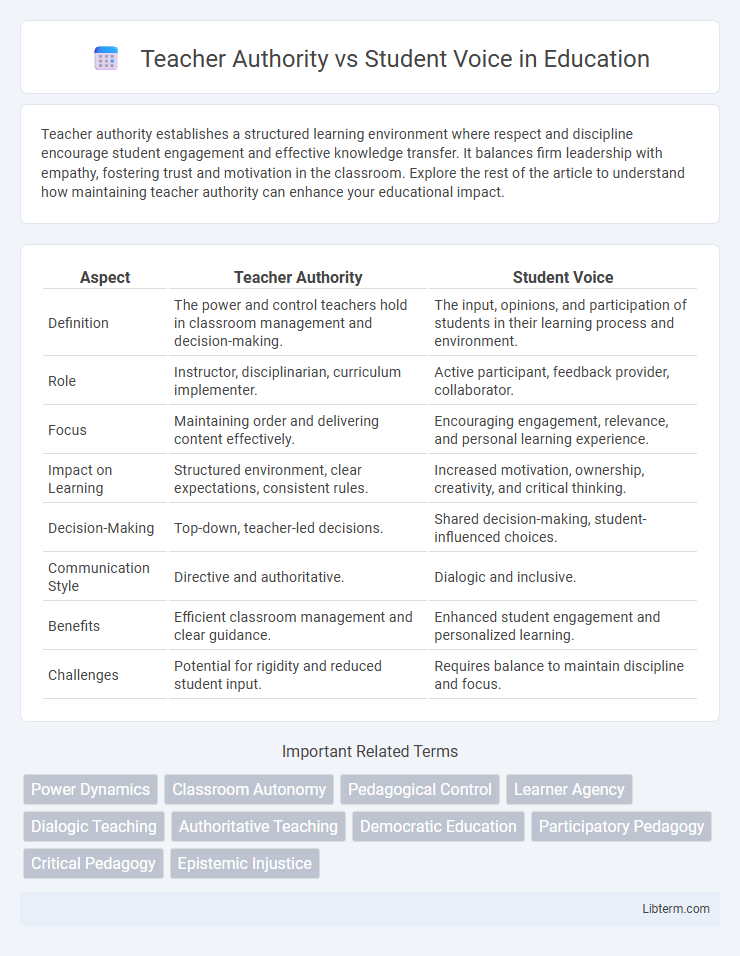Teacher authority establishes a structured learning environment where respect and discipline encourage student engagement and effective knowledge transfer. It balances firm leadership with empathy, fostering trust and motivation in the classroom. Explore the rest of the article to understand how maintaining teacher authority can enhance your educational impact.
Table of Comparison
| Aspect | Teacher Authority | Student Voice |
|---|---|---|
| Definition | The power and control teachers hold in classroom management and decision-making. | The input, opinions, and participation of students in their learning process and environment. |
| Role | Instructor, disciplinarian, curriculum implementer. | Active participant, feedback provider, collaborator. |
| Focus | Maintaining order and delivering content effectively. | Encouraging engagement, relevance, and personal learning experience. |
| Impact on Learning | Structured environment, clear expectations, consistent rules. | Increased motivation, ownership, creativity, and critical thinking. |
| Decision-Making | Top-down, teacher-led decisions. | Shared decision-making, student-influenced choices. |
| Communication Style | Directive and authoritative. | Dialogic and inclusive. |
| Benefits | Efficient classroom management and clear guidance. | Enhanced student engagement and personalized learning. |
| Challenges | Potential for rigidity and reduced student input. | Requires balance to maintain discipline and focus. |
Understanding Teacher Authority: Definitions and Roles
Teacher authority encompasses the legitimate power educators hold to guide classroom behavior, set academic standards, and manage learning environments, rooted in professional expertise and institutional roles. This authority enables teachers to create structured educational experiences, ensure discipline, and maintain a safe space conducive to student learning. Recognizing the boundaries and responsibilities of teacher authority is essential for balancing classroom control with respect for student autonomy and fostering an inclusive educational climate.
The Evolution of Student Voice in Modern Education
The evolution of student voice in modern education marks a shift from rigid teacher authority toward collaborative learning environments where students actively participate in decision-making processes. Research highlights that empowering student voice enhances engagement, critical thinking, and classroom dynamics by valuing learners' perspectives alongside instructional expertise. Contemporary educational models increasingly integrate student feedback, fostering shared responsibility and transforming traditional hierarchies for more inclusive pedagogy.
Benefits of Strong Teacher Authority in the Classroom
Strong teacher authority fosters a structured learning environment that enhances student engagement and academic achievement. Clear expectations and consistent discipline promote respect and minimize distractions, allowing focused instruction and meaningful dialogue. Establishing authority supports classroom management, enabling teachers to effectively guide and motivate students toward educational goals.
Empowering Student Voice: Why It Matters
Empowering student voice enhances engagement, critical thinking, and ownership of learning, fostering a collaborative classroom environment where diverse perspectives shape educational experiences. It challenges traditional teacher authority by promoting shared decision-making and respect for student insights, ultimately preparing learners for active participation in democratic societies. Research demonstrates that when students feel heard and valued, their motivation and academic outcomes significantly improve, highlighting the importance of balancing authority with authentic student empowerment.
Balancing Classroom Authority and Student Participation
Balancing classroom authority with student participation enhances learning by fostering mutual respect and engagement. Effective teachers establish clear boundaries while encouraging student input, creating an environment where diverse perspectives thrive. This equilibrium supports academic achievement and develops critical thinking and communication skills.
Challenges in Navigating Authority and Voice Dynamics
Navigating the dynamics between teacher authority and student voice presents challenges, as educators must balance maintaining classroom control while fostering open communication and student empowerment. Power imbalances can hinder genuine dialogue, making it difficult to create an inclusive environment where students feel their perspectives are valued. Effective strategies involve adaptive leadership, active listening, and collaborative decision-making to harmonize authority with participatory learning.
Impact on Student Engagement and Learning Outcomes
Teacher authority establishes clear expectations and structure, which can enhance student focus and discipline, directly influencing positive learning outcomes. Incorporating student voice fosters a sense of ownership and relevance in the learning process, increasing motivation and active engagement. Balancing authoritative guidance with student input creates an optimal learning environment that promotes deeper understanding and higher academic achievement.
Strategies for Harmonizing Authority and Student Voice
Effective classroom management balances teacher authority with student voice by implementing collaborative decision-making strategies that encourage mutual respect and active participation. Integrating student feedback into lesson planning and classroom rules fosters a sense of ownership and enhances engagement while maintaining clear teacher guidelines ensures structure and discipline. Employing restorative practices and open communication channels creates a supportive environment where authority is exercised with empathy and student perspectives are valued.
Case Studies: Successful Models and Real-World Examples
Case studies on teacher authority versus student voice reveal successful models where balanced interaction enhances learning outcomes, such as the democratic classrooms in Finland that emphasize student participation alongside authoritative guidance. Real-world examples include project-based learning environments in the United States, where teachers facilitate rather than dictate, promoting critical thinking and collaboration. These models demonstrate that integrating student voice with structured teacher leadership fosters engagement, responsibility, and academic achievement.
Future Directions: Rethinking Power Structures in Education
Future directions in education emphasize reimagining power dynamics by balancing teacher authority with amplified student voice to foster inclusive learning environments. Integrating participatory decision-making models enables students to contribute meaningfully, enhancing engagement and critical thinking skills. Research highlights that equitable power structures promote collaboration and democratic classroom cultures, preparing learners for active citizenship in diverse societies.
Teacher Authority Infographic

 libterm.com
libterm.com